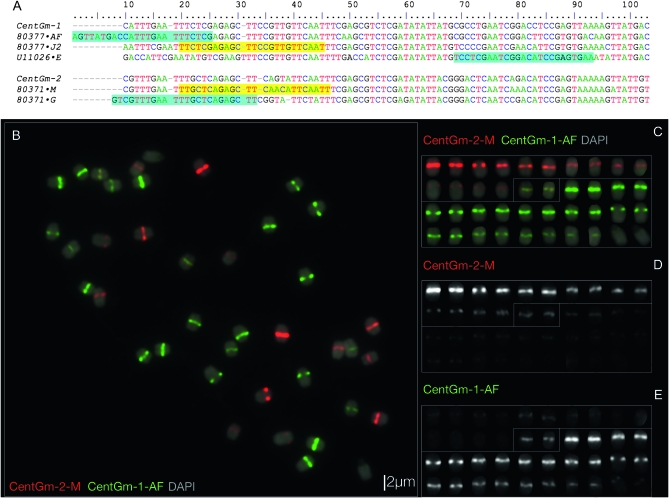Figure 1.—
Sequence and localization analysis of CentGm repeats in G. max W82. (A) ClustalW alignment of consensus DNA sequences of the most abundant CentGm family repeats identified by Swaminathan et al. (2007), together with U11026, a CentGm variant identified by Vahedian et al. (1995), in addition to CentGm-1 and CentGm-2, monomers identified by Gill et al. (2009). Two major CentGm repeat subtypes are evident: a 92-bp class (upper) and a 91-bp subtype (lower). Oligonucleotide probes used to target individual repeats are indicated after the sequence names (e.g. “·AF,” with a corresponding probe name of CentGm-AF). Oligonucleotide probes identical to a given sequence are indicated by yellow background, whereas those that are reverse complements are indicated by aqua background. Probes ·AF and ·G would each hybridize across the junction of two monomers; thus, the sequences are duplicated for these regions. Oligonucleotides CentGm-1-AF and CentGm-1-J2 target 24- or 25-bp sequences, respectively, conserved among members of the 92-bp repeat subtype, and oligonucleotide CentGm-1-E targets a specific variant of the 92-bp subtype. Oligonucleotide CentGm-2-M targets a consensus 25-bp sequence conserved among a fraction of the 91-bp repeat subtypes, whereas oligonucleotide CentGm-2-G targets a consensus 25-bp sequence conserved among most of the abundant 91-bp variants. (B–E) FISH of G. max W82 chromosomes with fluorochrome-tagged oligonucleotide probes targeting 91- and 92-bp CentGm repeats. The following oligonucleotide probes (amounts) were used per slide: fluorescein-CentGm-1-AF (20 ng) Texas red-615-CentGm-2-M (20 ng). (B) Chromosome spread probed with a red-fluorochrome-tagged CentGm-2-M oligonucleotide and a green-fluorochrome-tagged CentGm-1-AF oligonucleotide. The DAPI signal is included as a 25% intensity gray-scale channel to delineate chromosomes. (C) Individual chromosomes from B arrayed generally by color and intensity of CentGm hybridization signal. (D) The red channel (CentGm-2-M), excluding DAPI, of the chromosome array in C. (E) The green channel (CentGm-1-AF), excluding DAPI, of the chromosome array in C. Three types of chromosomes are apparent: 7 pairs (upper chromosomes in C–E) that hybridize predominantly to the red CentGm-2-M probe, 12 pairs (lower chromosomes in C–E) that hybridize to the green CentGm-1-AF probe, and a single pair (boxed in center in C–E) that hybridizes equally to both probes. Bar in B is also valid for C–E.

